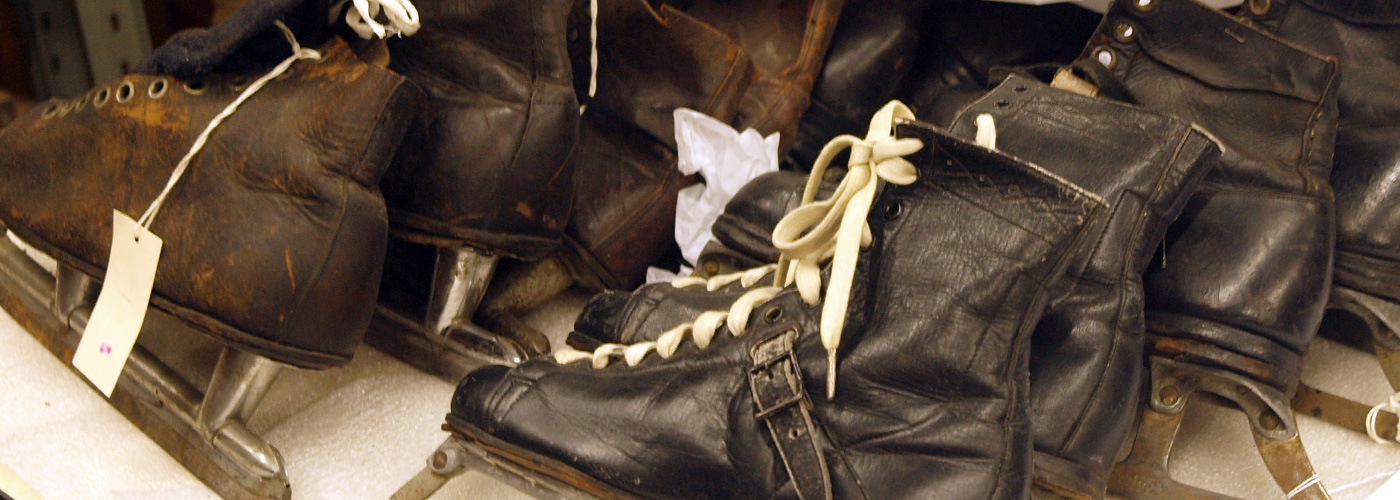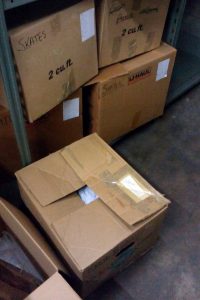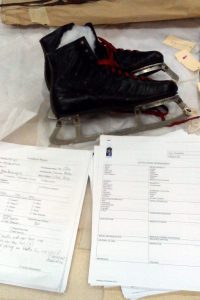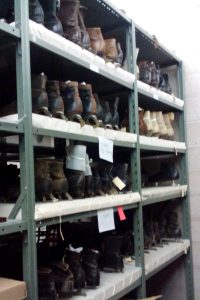Preserving and Protecting the Starr Skate Collection


Shannon Baxter
by Shannon Baxter
This is the seventh in a series of articles featuring Dartmouth’s Starr Manufacturing Company. Established as a nail factory in 1861, Starr Manufacturing soon began making its famous Starr skates and selling millions of pairs around the world from 1863 to 1939. The plant also played an important role in the sale of the first hockey sticks and excelled in other areas such as the production of the golden gates to Halifax’s Point Pleasant Park.
I am now more than halfway through my Starr skate project. It has been a very fun to work with all the skates that are in the collection. Though it was definitely a larger task than I initially anticipated! Which makes it all the more satisfying to step back and see how far I have gotten.
Instead of highlighting a particular skate, this time around I am going to highlight some of the steps I have taken while working on this project. From the inventorying of each skate to their eventual rehousing within the museum’s artifact storage facility.
 1) In the beginning, there were boxes….When I first started working on the Starr Skates. All of them were being stored in old acidic cardboard boxes. This is not appropriate storage for two reasons: First, the leather on half of the skates can maintain moisture when in a dark space, encouraging mold growth. Secondly, the way the skates were stored inside the boxes was haphazard and there was risk of leather being folded, bent, and blades being scratched against each other. A main goal for the end of the project would be to have all of these skates out of the old boxes and onto the shelves.
1) In the beginning, there were boxes….When I first started working on the Starr Skates. All of them were being stored in old acidic cardboard boxes. This is not appropriate storage for two reasons: First, the leather on half of the skates can maintain moisture when in a dark space, encouraging mold growth. Secondly, the way the skates were stored inside the boxes was haphazard and there was risk of leather being folded, bent, and blades being scratched against each other. A main goal for the end of the project would be to have all of these skates out of the old boxes and onto the shelves.
 2) Laying out the skates…To make my work more efficient, instead of working out of each individual box I lay out all of the skates on a table. There are thin ethafoam sheets underneath the artifacts, to minimize chances of abrasion or wear. Here are the “Blades Only” skates in the museum’s collection. Many of them are example of old wooden soled skates, but there are also a great deal of Starr Skates as well. In fact, some of the wooden soled skates have “Starr” on their metal blades. This is the second half of the collection, the other skates that have boots attached to them have already been inventoried and rehoused.
2) Laying out the skates…To make my work more efficient, instead of working out of each individual box I lay out all of the skates on a table. There are thin ethafoam sheets underneath the artifacts, to minimize chances of abrasion or wear. Here are the “Blades Only” skates in the museum’s collection. Many of them are example of old wooden soled skates, but there are also a great deal of Starr Skates as well. In fact, some of the wooden soled skates have “Starr” on their metal blades. This is the second half of the collection, the other skates that have boots attached to them have already been inventoried and rehoused.
 3) The paperwork…There are two different sheets that the museum fills for each artifact: A cataloging sheet, and a condition report sheet. The cataloging sheet is a more generalized form where one can write down the accession number assigned to the artifact, the dimensions, a description, and other notes of importance. There is also an area for recording the artifact’s condition. This information can be expanded upon in a separate condition report. These forms are important for the museum since they assist in better understanding their own collection. They have all the information in one place which can be used as a reference tool. Condition reports help inform the museum what aritfacts may need extra attention.
3) The paperwork…There are two different sheets that the museum fills for each artifact: A cataloging sheet, and a condition report sheet. The cataloging sheet is a more generalized form where one can write down the accession number assigned to the artifact, the dimensions, a description, and other notes of importance. There is also an area for recording the artifact’s condition. This information can be expanded upon in a separate condition report. These forms are important for the museum since they assist in better understanding their own collection. They have all the information in one place which can be used as a reference tool. Condition reports help inform the museum what aritfacts may need extra attention.
 4) Rehousing the skates…These are how the skates look after I have rehoused them in the museum’s storage facility. Those white blocks which the skates are sitting on are composed of stiff styrofoam sheets. The sheets were cut to fit in the shelves, and grooves carved into them so that the blades of each skate may fit snugly within them. The unbleached cotton wrapped around the sheets are to minimize any chances of minor abrasions that the styrofoam on its own may have caused. These are all of the ‘Booted” Skates that have already been inventoried and cataloged. It has been wonderful seeing them all set up in the storage facility. I am halfway done with the “Blades Only” skates, and look forward to seeing them all in their own shelves!
4) Rehousing the skates…These are how the skates look after I have rehoused them in the museum’s storage facility. Those white blocks which the skates are sitting on are composed of stiff styrofoam sheets. The sheets were cut to fit in the shelves, and grooves carved into them so that the blades of each skate may fit snugly within them. The unbleached cotton wrapped around the sheets are to minimize any chances of minor abrasions that the styrofoam on its own may have caused. These are all of the ‘Booted” Skates that have already been inventoried and cataloged. It has been wonderful seeing them all set up in the storage facility. I am halfway done with the “Blades Only” skates, and look forward to seeing them all in their own shelves!
The last stage of this project will be to photograph each skate. Photographic images are important for reference purposes and also for future exhibits that the museum may have. I am hoping to get to this stage within the next few weeks, once the skates have been completely cataloged.
Want to keep reading? Check out Shannon’s next article in the Starr series, A Soldier’s Skates and previous article here.
